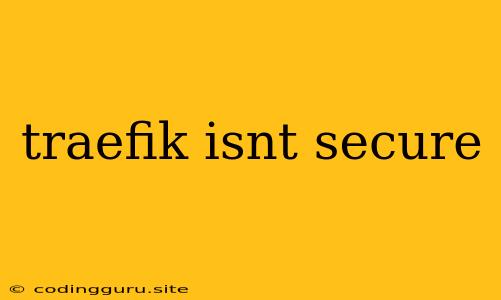Traefik Isn't Secure: What to Do?
Traefik is a powerful and popular reverse proxy and load balancer that can simplify your application's networking infrastructure. However, like any complex system, Traefik needs proper configuration to be secure. Leaving Traefik in its default configuration can expose your applications to serious security risks.
How Can Traefik Be Insecure?
Traefik, by default, comes with features that can be exploited if not configured correctly:
- Open to the World: Traefik listens on all interfaces by default, meaning anyone on your network can access it. This can be dangerous if your network isn't well-secured.
- No HTTPS Enforcement: Traefik allows unencrypted HTTP traffic by default. This means sensitive data could be intercepted without proper encryption.
- Default Credentials: Traefik ships with default credentials that are widely known. Anyone can access your Traefik dashboard with these credentials.
How to Make Traefik Secure?
Here's a step-by-step guide to secure your Traefik installation:
1. Restrict Access:
- Network Level: Limit Traefik's access to specific IP addresses or networks. Configure your firewall to only allow traffic from authorized sources.
- Traefik Configuration: Use the
entryPointssection in your Traefik configuration file (usuallytraefik.ymlortraefik.toml) to restrict access to specific network interfaces or IP addresses.
2. Enforce HTTPS:
- Traefik Configuration: Define a secure entry point for your Traefik service using TLS certificates. For example, you can create an entry point named
httpsthat listens on port 443 (HTTPS) and redirects HTTP traffic to HTTPS. - Use Let's Encrypt: Let's Encrypt offers free and automatic TLS certificates. Configure Traefik to use Let's Encrypt to obtain and renew certificates automatically.
3. Change Default Credentials:
- Traefik Configuration: Modify the
basicAuthsection in your Traefik configuration to define new, strong credentials for accessing the Traefik dashboard.
4. Use a Secure Web Server:
- Nginx or Apache: Traefik can work behind other secure web servers like Nginx or Apache. These servers can handle TLS termination and other security measures, while Traefik focuses on reverse proxying and load balancing.
Example Configuration:
entryPoints:
http:
address: ":80"
https:
address: ":443"
tls:
certResolver: le
domains:
- main.example.com
- www.example.com
5. Regularly Update Traefik:
- Security Updates: Keep Traefik up-to-date with the latest security patches by regularly updating to the newest versions.
- Security Advisories: Subscribe to Traefik's security advisories and implement any necessary fixes promptly.
6. Use Traefik's Built-in Security Features:
- Rate Limiting: Traefik has built-in rate limiting features. Configure these to prevent DDoS attacks and other malicious traffic.
- ACL (Access Control Lists): Implement ACLs to control access to specific routes or services based on IP address, headers, or other criteria.
- WAF (Web Application Firewall): Consider using a WAF to protect against common web attacks like SQL injection, cross-site scripting (XSS), and more.
7. Monitor for Security Threats:
- Log Analysis: Monitor your Traefik logs for suspicious activity, such as failed login attempts, unusual traffic patterns, or error messages.
- Security Monitoring Tools: Consider using security monitoring tools to automatically detect and alert you to potential threats.
Conclusion:
Traefik is a powerful tool, but securing it is critical. By following these steps, you can significantly reduce the risk of security vulnerabilities and protect your applications and data. Remember, a secure Traefik deployment requires ongoing vigilance and attention to security best practices.
